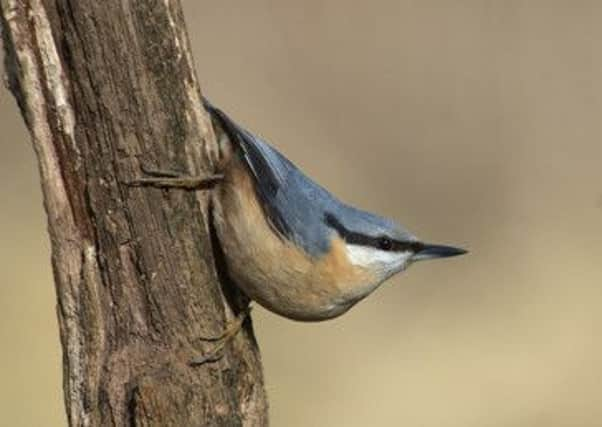Birdwatch: Nuthatches


If you see one running head first down a tree trunk it will be a nuthatch, the only European bird that can do this.
Woodpeckers get around trees by using their stiff tails as a prop but the nuthatch relies solely on its strong claws.
Advertisement
Hide AdAdvertisement
Hide AdIt is a most attractive bird with a steel-blue back, dark line through the eye and pale underparts flushed with pink.
Nuthatches call a lot in winter, a run of sharp silvery whistles, but from now on begin their spring calls, a loud drawn out single whistle or a kee-kee-kee call rather like a kestrel.
They nest in tree holes, the females closing up nest entrances with dried mud until a small hole is left that they can enter but other birds can’t.
Most pairs stay together on their territory throughout the winter and the first eggs are laid in April continuing until the end of May.
Advertisement
Hide AdAdvertisement
Hide AdIn recent years milder winters have resulted in nuthatches laying earlier and rearing larger broods so numbers have increased. They have also expanded north as far as the Scottish lowlands where breeding was first recorded in Dumfries and Galloway in 2005.
In Yorkshire, nuthatches remain a scarce bird in some parts such as Holderness, probably because suitable woodland is scattered and nuthatches are reluctant to travel too far over open ground.
Nuthatches are now more frequent visitors to bird feeders than they used to be, skilfully extracting peanuts from the feeders and flying off with them; chasing off other birds such as greenfinches while doing so. This provides plenty of opportunities for photographers at sites such as the Forge Valley feeding station near Scarborough.
Another small bird that climbs tree trunks is the treecreeper but, unlike the nuthatch, it can only go up in a series of little jumps. Once it has reached the top of a trunk it will often fly to the bottom of the next tree to start again giving a glimpse of its silvery white underparts.
Advertisement
Hide AdAdvertisement
Hide AdTreecreepers are tough little birds and will survive quite hard winters but with this winter’s relative mild conditions up until this week plenty of treecreepers have been seen.
A drake American wigeon was seen with a large flock of Eurasian wigeon on the main lake at Swillington Ings, Leeds on Sunday while two black-necked grebes are still there.
A ring-tail hen harrier was seen in field around North Duffield Carrs near Selby, and up to four including two males have continued to roost on Blacktoft Sands reserve along with 20 marsh harriers, merlins and peregrine falcons.
On the east coast up to six short-eared owls and one long-eared were at Buckton while a black redstart was present at the Easington gas terminal.
A bittern was heard booming on the Fairburn Ings reserve near Castleford while several bearded tits and a smew are among other sightings. Two bearded tits were seen at Hornsea Mere.